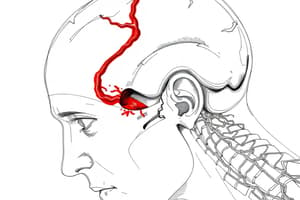Podcast
Questions and Answers
What is the process referred to that describes the standard set of data collected by regional trauma centers?
What is the process referred to that describes the standard set of data collected by regional trauma centers?
The trauma registry
What is the goal for incident-to-surgery time for trauma patients, known as?
What is the goal for incident-to-surgery time for trauma patients, known as?
Golden Period
What does the term 'index of suspicion' refer to?
What does the term 'index of suspicion' refer to?
A mental summation of anticipated injuries based on your event analysis
What criterion must a facility fulfill to qualify as a trauma center?
What criterion must a facility fulfill to qualify as a trauma center?
What is the leading killer of persons between the ages of 1 and 44?
What is the leading killer of persons between the ages of 1 and 44?
What is the most common cause of trauma resulting in activation of the EMS system?
What is the most common cause of trauma resulting in activation of the EMS system?
What cause of death is exceeded only by cardiovascular disease and cancer across all age brackets?
What cause of death is exceeded only by cardiovascular disease and cancer across all age brackets?
In patients with serious life-threatening trauma, what type of injury is typically life-threatening?
In patients with serious life-threatening trauma, what type of injury is typically life-threatening?
What is the collection of data to identify the existence, significance, and characteristics of a disease called?
What is the collection of data to identify the existence, significance, and characteristics of a disease called?
What is the name of the tool developed to identify risk elements associated with trauma?
What is the name of the tool developed to identify risk elements associated with trauma?
What is the term for the creation or modification of programs aimed at reducing trauma incidence?
What is the term for the creation or modification of programs aimed at reducing trauma incidence?
What is the important intervention method that can help prevent recurrence of carelessness or disregard for safety?
What is the important intervention method that can help prevent recurrence of carelessness or disregard for safety?
What trauma care rating does a hospital that attempts non-surgical stabilization of critical trauma patients prior to transport have?
What trauma care rating does a hospital that attempts non-surgical stabilization of critical trauma patients prior to transport have?
What trauma center designation is given to a regional center prepared to handle all types of specialty trauma?
What trauma center designation is given to a regional center prepared to handle all types of specialty trauma?
What rating does a community-based trauma center with a commitment to trauma patient care receive?
What rating does a community-based trauma center with a commitment to trauma patient care receive?
Which definition describes a Level III trauma center?
Which definition describes a Level III trauma center?
How would you rate the priority status of a victim who is unconscious and bleeding heavily?
How would you rate the priority status of a victim who is unconscious and bleeding heavily?
Based on the CUPS triage scheme, what describes a patient with a 'critical' designation?
Based on the CUPS triage scheme, what describes a patient with a 'critical' designation?
What is the CUPS rating for a patient who is ashen and has a respiratory rate of 24?
What is the CUPS rating for a patient who is ashen and has a respiratory rate of 24?
Flashcards are hidden until you start studying
Study Notes
Trauma Registry
- A standardized set of data collected by regional trauma centers to analyze patient types and injuries addressed by EMS.
- Used to assess system performance and identify factors affecting patient survival.
Golden Period
- Refers to the critical time frame for incident-to-surgery for trauma patients.
Index of Suspicion
- A mental process where anticipated injuries are summarized based on event analysis.
Trauma Center Criteria
- Facilities must commit resources specifically for providing trauma care to qualify as a trauma center.
Leading Cause of Death
- Trauma is the leading cause of death for individuals aged 1 to 44.
Common Cause of Trauma
- Falls are the most prevalent trigger for EMS system activation due to trauma.
Overall Causes of Death
- Trauma ranks as the cause of death, surpassed only by cardiovascular disease and cancer.
Life-Threatening Injuries
- In serious trauma cases, life-threatening injuries are usually internal in nature.
Surveillance
- Refers to the collection of data aimed at identifying the existence and characteristics of diseases.
Haddon Matrix
- A tool designed to identify risk elements linked to trauma.
Intervention Development
- Involves creating or modifying programs aimed at reducing both the frequency and severity of trauma incidents.
Teachable Moment
- An effective intervention suggesting behavior changes to prevent recurrent incidents related to carelessness or safety disregard.
Trauma Care Rating Levels
- Level IV: Hospitals that focus on non-surgical stabilization before transferring critical patients.
- Level I: Comprehensive trauma centers, often university hospitals, equipped to handle all specialty trauma cases.
- Level III: Community-based trauma centers offering specialized staff training and resource allocation for trauma care.
Critical and Unstable Designations
- Critical: Patients unable to secure airway, breathing, or circulation.
- Unstable: Patients exhibiting signs of severe compromise, such as tachycardia and altered consciousness.
CUPS Triage Scheme
- A system used to classify patients based on their condition during triage, aiding in prioritization and response.
Emergency Response Scenario
- In cases of severe trauma, such as falls from heights, patients may display significant physiological distress and altered consciousness, necessitating urgent medical intervention.
Studying That Suits You
Use AI to generate personalized quizzes and flashcards to suit your learning preferences.




